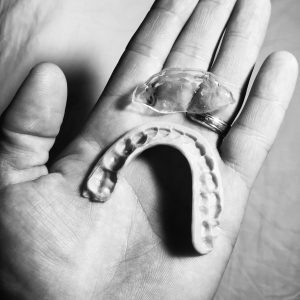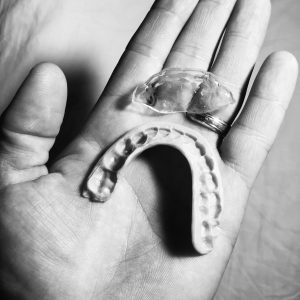 TMJ dysfunciton happens to dentists, too.
TMJ dysfunciton happens to dentists, too.
Sitting at the office computer after seeing a patient – following up after the delivery of an occlusal guard. As I was talking with him, I was reminded about what has happened to my personal occlusal guards over the years.
Here’s some general information for those of you uninitiated to the world of TMJ problems such as joint noises, headaches, clenching and grinding:
When someone has discomfort in either of their TMJs [ L and R jaw joints] or headaches, or they are wearing their teeth down to little itsy-bitsy nubbins, or they chip and break teeth/crowns/veneers, [or other bad situations with their teeth, muscles or joints], we tend to recommend an occlusal guard to help limit that damage, or improve their condition.
When an occlusal guard [night guard, bite guard, bite splint] is part of someone’s treatment plan, one of the most common questions we get is, “How long will one of these last?”.
My answer is nearly always the same, “It depends.”
- How well is it taken care of?
- How often do you wear it?
- What is the diagnosis, and treatment plan?
Of all these questions, I think the “How well is it taken care of?” question is the most influential in regards to longevity of this little piece of plastic.
We often talk about how to care for your occlusal guard at the initial delivery appointment, but let me give you the run-down here:
- Rule #1 – Keep it in the case, or in your mouth.
- Rule #2 – Insert it and remove it with clean fingers, not your teeth or tongue.
- Rule #3 – Keep a cup of water at your bedside. When you wake up in the morning, [or the middle of the night] drop the guard into the water to help dilute saliva and reduce mineral build up. Brush it lightly after you brush your teeth, Rinse, and let it dry in the case.
- Rule #4 – Bring it with you to every dental appointment.
I have been wearing an occlusal guard every night since my third year of dental school in 2006. In the 10 years since, I have owned 3 different guards. The first was made by my father, who you can find here, and lasted 2-3 years. At that time, my wife and I became new parents, and had a baby that had trouble falling asleep. The books we read suggested imitating the noises in the womb by making “shhh” sounds. One of those late nights at 3am – it was my turn to try and get her back to sleep. And I was having a hard time making the “sh” noise with the guard in my mouth. I took it out and, because there were no pockets in my boxer shorts, wrapped it in a tissue and set it on the counter.
The next evening, I got ready for bed and could not find my occlusal guard. I struggled to figure out what had happened to it. Baby-brain is real! When I finally recalled the previous evenings events, I went out to the kitchen to retrieve it and – it was gone. My mother-in-law had cleaned up, and because it was wrapped in tissue thought it to be garbage. She also was nice enough to take the garbage out to the curb which was picked up earlier. Remember Rule #1?
My TMJ suffered unitl I made myself another occlusal guard – about 2 weeks – and this one lasted until my second course at the Pankey Institue in 2011. During that course, we paired up and made each other new appliances. This new one was more comfortable for me, so the old one went into a drawer.
Fast forward to 2015. My family and I had made the drive from Ohio to Laguna Niguel, CA once with the kids, and my wife and I were on our second trip. We decided to drive through the night, and get some rest at a truck-stop when we felt tired. We made it all the way to Iowa, pulled off, and slept in the car. In the morning, I went to the bathroom with my toothbrush. Because I didn’t have my bag with me, I slipped my occlusal guard into my back pocket [see how I remembered not to wrap in in tissue?]. When I got back to the car, I sat down in the front seat and heard a “snap”. My heart sank. I reached into my back pocket, and pulled out my beloved appliance to view the horror and destruction. It was better than I feared – I only broke the back tooth off. Other than a sharp edge, it fit just fine. I bought an emery board from CVS and problem solved.
Now, it’s January of 2017.
Stop 8:30 to do a hygiene check and see a patient in my chair.
Start 10:08 – Waiting for x-rays to be made.
We continue. It’s January and I’m wearing a temporary appliance Dr. Gregg calls a “MAPA” [Maxillary Anterior Positioning Appliance]. It’s essentially a small muscle deprogrammer made with a thermoplastic material moulded over a stone cast. I have one of these because this is what happened over the holidays:
I woke up and all of the bathrooms in the house were occupied. I hear my parents out in the kitchen, and the smell of coffee is too tempting. There’s a plate of Hungarian pastries on the table. I pour myself a cup of coffee, sit down, and take my occlusal guard out and put it in the front pocket of my pajama pants [not my back pocket, not a tissue]. The coffee is delicious. My parents have a “Mocha Master” coffee maker. It makes the very best cup of drip coffee from a machine – not as good as pour-over, but close.
Later that day, after lunch, my wife presented my occlusal guard to me. “I’m so sorry,” she said, “I washed and dried it. I hope it still fits.” I tried it in. It didn’t. The heat from the dryer warped it enough that it became unusable.
Here is the answer to the “how long do they last?” question. It depends. I have destroyed each of mine within 5 years time, but not because of anything dental. Each and every time, it was my mistake for not following the directions I give to each and every patient. I have some patients with appliances that are over 10 years old. The patients that wear them tend to have less emergencies with their teeth, fewer headaches, less pain. The patients that should wear them and don’t, tend to see us more often. I think they provide one of the biggest values in dentistry, no matter how long it takes you to destroy them.
Thanks for reading!
Dr. Dan

